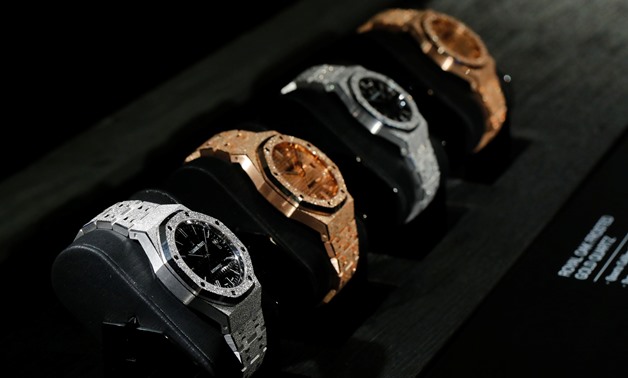
Royal Oak models are pictured on the Audemars Piguet stand at the "Salon International de la Haute Horlogerie" (SIHH) watch fair, in Geneva, Switzerland January 15, 2018. Picture taken January 15, 2018. REUTERS/Denis Balibouse
GENEVA - 19 January 2018: Swiss luxury watchmaker Audemars Piguet said it would launch a second-hand business this year, becoming the first big brand to announce plans to tap into a fast-growing market for pre-owned premium watches.
The company told Reuters it had carried out a test run in one store in Geneva and would launch the business more widely at its outlets in Switzerland this year. If this proved successful, it said it would roll out the operation in the United States and Japan.
“Second-hand is the next big thing in the watch industry,” Chief Executive Francois-Henry Bennahmias told Reuters in an interview at the SIHH watch fair in Geneva this week.
Luxury watchmakers have hitherto eschewed the second-hand trade, fearing diluting the exclusivity of their brands and cannibalizing their sales. They have instead ceded the ground to third-party dealers.
But some are now looking to change tack, driven by an industry-wide sales slowdown combined with a second-hand market that is expanding rapidly, fueled by online platforms like Chrono24 and The RealReal.
“At the moment, in watches, we leave it to what I call the ‘dark side’ to deal with demand for pre-owned pieces,” added Bennahmias, whose company is known for its octagonal Royal Oak timepieces that sell for 40,000 Swiss francs ($41,680) on average.
“Anybody but the brands (is selling second hand) - it’s an aberration commercially speaking,” he said, without giving any details about how they would price pre-owned watches.
Several smaller brands, including H.Moser & Cie and MB&F, have signaled interest in the second-hand trade.
“It is important to control the sale of second-hand watches to protect the owners and the value of watches already in the market by keeping the grey market in check,” H.Moser & Cie boss Edouard Meylan told Reuters.
MB&F, which plans to launch second-hand sales via its website this year, told Reuters it expected to typically give a 20-30 percent discount on second-hand watches. A spokesman said customers buying from established watch brands could feel confident they were getting genuine products in good working order and with a valid warranty.
Bigger brands Rolex, Patek Philippe, Swatch Group, Richemont and Breitling all declined to comment, when asked whether they planned to enter the second-hand market, while LVMH’s watch division was not immediately available.
‘WATCHES BY THE BUCKET’
Audemars Piguet said it would launch its second-hand business in several, but not all, of its 26 Swiss outlets, but declined to specify how many stores or give a more precise date.
It will initially allow customers to trade in old Audemars Piguet watches as part-exchange for new ones, and then sell on the second-hand watches. It has not yet decided whether to buy second-hand watches for cash, added the firm, saying its sales had come close to the 1 billion Swiss franc mark last year.
Experts say the second-hand luxury watches business, mostly done via online platforms or specialized retailers, is growing rapidly as a new generation of customers that values variety more than permanent ownership enters the luxury world.
In an example of the discounts offered online, a diamond-studded Audemars Piguet Royal Oak “with moderate scratches” sells for $9,450 on The RealReal, about a third of the “estimated retail price”.
Kepler Cheuvreux analyst Jon Cox said he estimated the size of the second-hand market at around $5 billion a year in revenue, including watches sold at auction, and that it had outperformed the market for new pieces in the last couple of years.
That is still dwarfed by a new luxury watch sector worth 37 billion euros ($45.3 billion), according to consultancy Bain & Cie. However Swiss watch exports fell 3.3 percent in 2015 and 9.9 percent in 2016 before posting a modest 2.8 percent rise in the first 11 months of 2017.
The United States, where sales of new watches have been falling for years, is the number one market for pre-owned watches, followed by Britain and Japan, said U.S. retailer Danny Govberg, who sells new watches for Rolex and other brands, but also an increasing number of second-hand timepieces.
His company said its second-hand sales had grown by 37-40 percent year-on-year over the past five years. In an example of prices, it said it listed a second-hand Audemars Piguet Royal Oak for $24,950 compared with a $32,000 retail price.
Together with a partner in Hong Kong and a Singapore-based investor, Govberg recently launched global e-commerce platform WatchBox for buying and selling pre-owned luxury watches.
“People sell us watches by the bucket,” he said.
He said many people sold watches to buy a new one so the pre-owned market was actually driving new sales, like in the car market. “The brands are still trying to figure it out, they don’t have the solution yet,” he said.
Audemars Piguet’s Bennahmias said watchmakers had to amend business models to deal with changing consumer habits.
“We’re witnessing a social and cultural change that forces us to think about what the business will look like in five or 10 years,” he added. “Time flies, we need to watch out.”
($1 = 0.9597 Swiss francs; $1 = 0.8173 euros)


Comments
Leave a Comment